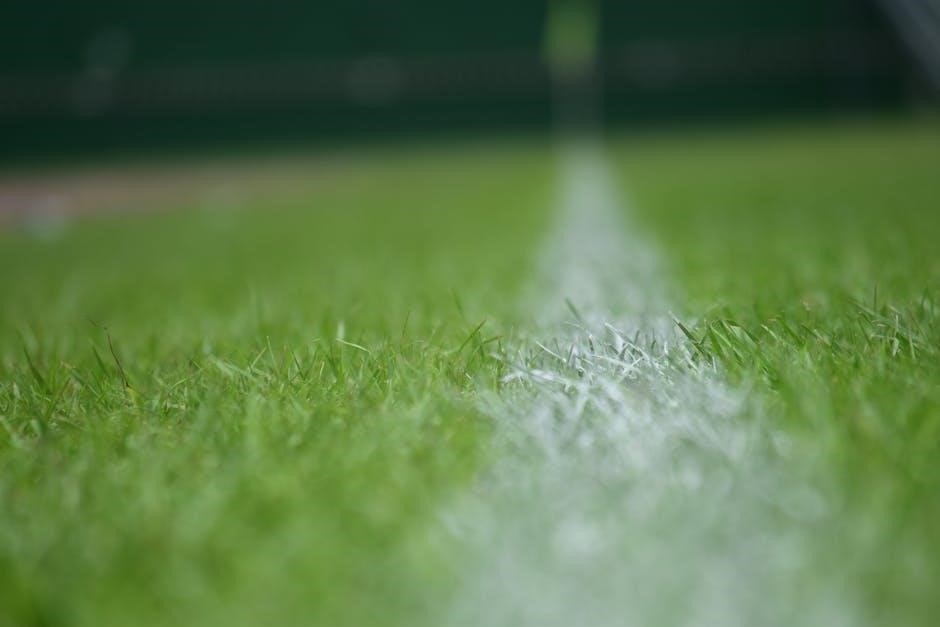
Sod leveling ensures your lawn is even and visually appealing․ It involves adjusting the ground surface to create a smooth, uniform area, enhancing both the appearance and functionality of your outdoor space effectively․
What is Sod Levelling?
Sod leveling is the process of creating a smooth, even surface on your lawn by adjusting the ground’s elevation․ It involves identifying uneven areas, removing sod, and redistributing soil to achieve a uniform ground level․ This technique ensures proper drainage, improves aesthetics, and makes lawn maintenance easier․ Sod leveling is essential for newly installed lawns or areas with significant terrain irregularities․ By addressing high and low spots, you can prevent water pooling and create a visually appealing outdoor space․ The process requires careful assessment and precise adjustments to ensure the lawn remains healthy and functional․ Whether you’re addressing minor unevenness or major grading issues, sod leveling is a practical solution for achieving a flawless lawn surface․ It’s a crucial step for homeowners seeking to enhance their property’s curb appeal and functionality․ With the right tools and techniques, you can transform an uneven lawn into a pristine, professional-looking area․
Why is Sod Levelling Important?
Sod leveling is crucial for achieving a uniform and visually appealing lawn․ Uneven ground can lead to water pooling, poor drainage, and uneven grass growth, which can damage the lawn over time․ By leveling the sod, you ensure proper water distribution, preventing erosion and promoting healthy root development․ A level lawn also enhances safety, as uneven surfaces can be tripping hazards․ Additionally, it improves the overall aesthetic of your outdoor space, making it look well-maintained and professionally groomed․ Leveling also makes lawn maintenance easier, as mowing and other tasks become more efficient․ Finally, a level lawn increases your property’s curb appeal, boosting its value and creating a welcoming environment for outdoor activities․ In summary, sod leveling is essential for functionality, safety, and visual appeal, ensuring your lawn remains healthy and attractive for years to come․

Preparation
Before leveling, gather essential tools like shovels, rakes, and a wheelbarrow․ Assess your lawn’s terrain to identify high and low spots, ensuring a clear plan for a smooth leveling process ahead․
Tools and Materials Needed
To successfully level your sod, you’ll need the right tools and materials․ Start with a shovel for digging and moving soil, and a rake to smooth out the ground․ A wheelbarrow or garden cart is essential for transporting soil and sod․ For precision, use a laser level or a spirit level to ensure evenness․ A sod cutter can help remove existing sod efficiently, while a trowel or edger is useful for finer adjustments․ Don’t forget gloves, knee pads, and sturdy footwear for comfort during the process․ Additionally, keep sand or compost on hand to fill low spots and improve drainage․ Lastly, a watering hose is crucial for keeping the sod hydrated after laying it back․ Having all these tools ready will streamline the process and ensure a professional-looking result․
Understanding Your Lawn Terrain
Before leveling your sod, it’s crucial to assess your lawn’s terrain․ Identify high and low spots by walking across the lawn or using tools like a laser level․ Note any uneven areas, slopes, or drainage issues․ Consider the soil type—clay, sand, or loam—as this affects how easily you can level the ground․ If your lawn has existing sod, check for soft or spongy spots that may indicate uneven soil beneath․ Also, observe how water drains across the lawn; poor drainage can lead to further unevenness․ Understanding your terrain helps you determine the extent of leveling needed and the best approach to achieve a smooth surface․ This step ensures your sod leveling efforts are effective and long-lasting, preventing future issues like water pooling or uneven growth․

Step-by-Step Guide
Leveling sod involves assessing, marking, and adjusting the lawn surface․ Remove sod, level the soil, and lay it back evenly․ This process ensures a smooth, uniform lawn appearance and proper drainage․
Assessing the Lawn
Begin by thoroughly evaluating your lawn to identify uneven areas․ Walk across the lawn and note any low spots, mounds, or uneven gradients․ Check for drainage issues, as water pooling indicates low areas․ Use a rake or shovel to gently probe the ground, feeling for soft or uneven spots․ Look for areas where the sod is thinning or where the grass is uneven․ Consider the overall slope of your lawn, ensuring it drains away from your home․ Documenting these observations will guide your leveling process․ It’s important to address these issues before laying new sod to ensure proper growth and aesthetics․ A detailed assessment is crucial for achieving a smooth, even lawn surface․
Marking High and Low Spots
Once you’ve assessed your lawn, the next step is to mark the high and low spots․ Use stakes or small flags to identify uneven areas, ensuring they’re clearly visible․ For low spots, scrape the surface gently with a rake to expose the soil․ For high spots, mark the edges with spray paint or a hose to guide your sod removal․ This step helps you visualize the areas that need adjustment and ensures accuracy during the leveling process․ Proper marking is essential for achieving a smooth, even surface․ By clearly identifying these problem areas, you can address them systematically, ensuring your lawn is level and visually appealing․ This step sets the foundation for successful sod leveling․
Removing Sod
Once high and low spots are marked, it’s time to remove the sod from these areas․ Use a sod cutter or a sharp shovel to carefully cut and lift the sod․ For smaller areas, a shovel is sufficient, while a sod cutter is more efficient for larger sections․ Cut the sod into manageable strips, about 12 inches wide, to make handling easier․ Remove the sod gently to avoid tearing the grass or damaging the soil beneath․ If the sod is too thick, you can cut it into smaller pieces or use a utility knife to score the underside․ Work in small sections to maintain accuracy and prevent soil disturbance․ After removing the sod, set it aside for relaying later․ This step ensures you can address uneven areas without wasting materials․
Leveling the Soil
After removing the sod, the next step is to level the soil․ This ensures the ground is even and properly prepared for relaying the sod․ Use a rake or shovel to redistribute soil, filling in low spots and flattening high areas․ For larger areas, a leveling tool or laser level can help achieve precision․ Work in small sections to maintain accuracy and avoid over-compacting the soil․ Once the soil is evenly distributed, use a hand tamper or plate compactor to firm it up, ensuring stability․ Proper leveling prevents water pooling and uneven grass growth․ Double-check the surface with a spirit level or string line to confirm it’s even․ Finally, smooth out the soil with a rake to create a uniform surface for laying the sod back․ This step is crucial for a professional-looking lawn that drains well and grows evenly․
Laying Sod Back
Laying sod back is the final step in the sod leveling process, requiring careful attention to ensure proper alignment and even distribution․ Start by positioning the first piece of sod at the edge of your lawn, aligning it with a string or marker for a straight line․ Lay subsequent pieces end-to-end, staggering the joints between rows to prevent weak spots․ Use a shovel or sod cutter to trim pieces to fit irregular areas, such as around trees or garden beds․ After laying all pieces, water the sod thoroughly to keep it moist and encourage root growth․ Use a lawn roller to gently press the sod into the soil, ensuring good contact and eliminating air pockets․ Avoid walking on the sod until it has rooted, typically within a few weeks․ Properly laying the sod ensures a lush, even lawn that will thrive with minimal maintenance․

Advanced Techniques
Advanced sod leveling techniques include using laser levels for precision and employing specialized tools to handle uneven ground, ensuring a perfectly even surface efficiently and effectively every time․
Using a Laser Level

Utilizing a laser level is a highly efficient method for achieving precise ground leveling․ This tool emits a continuous beam of light that indicates the desired surface plane, allowing for accurate measurements across the entire lawn area․ By setting up the laser level on a tripod and calibrating it according to the manufacturer’s instructions, you can identify high and low spots effortlessly․ Mark these areas with stakes or paint to guide your sod removal and soil adjustment processes․ The laser level ensures that once the sod is laid back, the surface will be uniformly even, eliminating any noticeable unevenness․ This advanced technique is particularly useful for larger lawns or for those seeking professional-grade results․ Regularly checking the laser’s accuracy during the process helps maintain consistency and avoids costly rework․ Incorporating a laser level into your sod leveling routine significantly enhances the final outcome, making it a worthwhile investment for both homeowners and professionals alike․
Handling Uneven Ground
Dealing with uneven ground is a critical step in sod leveling, as it directly impacts the final result․ Start by assessing the lawn to identify high and low spots․ Use tools like a shovel or sod cutter to remove sod from elevated areas, carefully setting it aside for reuse․ For low-lying sections, fill in the gaps with additional soil, ensuring it’s spread evenly․ A wheelbarrow and rake can help redistribute soil smoothly․ After adjusting the soil, compact it using a hand tamper or plate compactor to prevent settling․ Avoid over-compacting, as this can damage the soil structure․ Once the ground is even, lay the sod back, ensuring tight seams and proper alignment․ Regularly water the area to promote healthy growth and settle the soil further․ By addressing uneven ground methodically, you create a stable and visually appealing base for your sod, ensuring long-term durability and a professional finish․

Tips for Success

Water the sod thoroughly after leveling to settle the soil․ Maintain regular lawn care, including mowing and fertilizing, to ensure healthy growth․ Use a rake to even out minor imperfections and check for proper drainage to avoid water pooling, ensuring a lush, uniform appearance over time․
Watering After Levelling
Proper watering after sod leveling is crucial for establishing a healthy lawn․ Immediately after laying the sod, water the entire area thoroughly to settle the soil and eliminate air pockets․ Keep the soil consistently moist during the first few weeks, but avoid overwatering, which can lead to pooling and uneven settling․ Water lightly in the morning and evening to prevent evaporation and ensure the roots receive adequate moisture․ Gradually reduce watering as the sod establishes itself, transitioning to a deeper, less frequent watering schedule to encourage root growth․ Proper hydration ensures the sod adheres well to the soil, promoting a lush and even appearance․ Regular monitoring of soil moisture will help maintain optimal conditions for your newly leveled lawn․
Maintaining the Lawn Post-Levelling

Maintaining your lawn after sod leveling is essential to preserve its even appearance and health․ Regular mowing at the recommended height for your grass type helps maintain uniformity and prevents scalping․ Fertilization should be done seasonally, using a balanced fertilizer to promote healthy growth and color․ Aeration and dethatching annually can improve drainage, reduce thatch buildup, and enhance root development․ Monitoring for pests, diseases, and weeds is crucial; address issues promptly to prevent widespread damage․ Proper watering schedules, as discussed earlier, should continue to support root health without over-saturating the soil․ Edging and trimming around borders and plants keeps the lawn looking tidy․ Lastly, inspect the lawn periodically for any settling or uneven areas and make necessary adjustments to maintain a smooth, level surface․ Consistent care ensures your lawn remains vibrant and even long after leveling․

Common Mistakes
Common mistakes include over-leveling, which can create uneven drainage, and not compacting the soil properly, leading to settling issues․ Always check grades and compact thoroughly to ensure stability and even growth․
Over-Leveling
Over-leveling is a common mistake that can lead to significant issues with your lawn․ It occurs when too much soil is removed, creating a surface that is too flat or even concave․ This can result in poor drainage, as water may pool in low-lying areas rather than draining naturally; Over-leveling can also disrupt the lawn’s ability to breathe, potentially causing root systems to suffer from a lack of oxygen․ Additionally, removing too much sod can expose the underlying soil to erosion, especially during heavy rain or irrigation․ It’s essential to level carefully, ensuring that the ground remains evenly sloped and that the sod is laid back in a way that maintains proper drainage and structural integrity․ Regular checks and gradual adjustments can help prevent this mistake, ensuring a healthy and aesthetically pleasing lawn․

Not Compacting the Soil
Failing to compact the soil after leveling is a critical error that can undermine the stability of your lawn․ When the soil isn’t properly compacted, it can settle unevenly over time, leading to dips and uneven surfaces that compromise the appearance of your sod․ This can also create soft spots where the ground feels spongy underfoot, making it difficult to maintain a consistent mow height․ Additionally, un-compacted soil may not provide adequate support for the sod, leading to poor root development and a higher risk of erosion․ To avoid this, use tools like a hand tamper or a plate compactor to ensure the soil is firmly packed before laying the sod․ Proper compaction ensures long-lasting results and a lawn that remains smooth and resilient for years to come․ It’s a simple step that makes a significant difference in the final outcome of your sod leveling project․
Proper sod leveling transforms your lawn into a beautiful, even space․ By following the guide, you’ll achieve professional results․ Remember to maintain your lawn post-leveling for lasting success and curb appeal․
Final Checklist
To ensure a successful sod leveling project, follow this final checklist: Inspect the lawn for evenness and proper drainage․ Water the sod thoroughly after laying it down․ Maintain regular watering for the first few weeks to promote root establishment․ Avoid heavy foot traffic until the sod is fully rooted․ Apply a starter fertilizer to support healthy growth․ Monitor for pests or diseases and address them promptly․ Keep mowing and maintenance schedules consistent to uphold the lawn’s appearance․ Regularly check the soil moisture to prevent overwatering․ Ensure the sod is laid on properly compacted soil to avoid future settling issues․ By following these steps, your lawn will remain level, healthy, and visually appealing for years to come․